Your Location:Home >Produts >API >25316-40-9
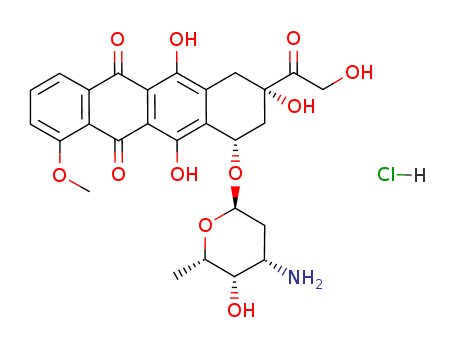

Product Details
|
Indications |
Doxorubicin is a potent antitumour agent active against a wide spectrum of malignancies, including leukaemias, sarcomas, breast cancer, small cell lung cancer and ovarian cancer. Doxorubicin is used to produce regression in disseminated neoplastic conditions like acute lymphoblastic leukemia, acute myeloblastic leukemia, Wilms’ tumor, neuroblastoma, soft tissue and bone sarcomas, breast carcinoma, ovarian carcinoma, transitional cell bladder carcinoma, thyroid carcinoma, gastric carcinoma, Hodgkin's disease, malignant lymphoma and bronchogenic carcinoma in which the small cell histologic type is the most responsive compared to other cell types. Doxorubicin is also indicated for use as a component of adjuvant therapy in women with evidence of axillary lymph node involvement following resection of primary breast cancer. Doxorubicin does not playa crucial role in the treatment of tumours that can be cured with chemotherapy, such as testicular carcinoma, nephroblastoma, Burkitt's tumour and choriocarcinoma[3]. Like most other cytostatic agents, doxorubicin is not effective in the most frequently occurring malignancies such as colorectal cancer and non-small cell lung cancer. |
|
Mechanism of action |
Doxorubicin has antimitotic and cytotoxic activity through a number of proposed mechanisms of action, however, remaining not fully understood: Data pointing to the role of free radicals, and to damage of mitochondria and membranes, have modified the original hypothesis that DNA-intercalation was the sole cytotoxic mechanism. Meanwhile, the focus on plasma pharmacokinetics has been shifted towards pharmacodynamic studies, with emphasis on cellular doxorubicin concentrations in haematopoietic tissues[4], in solid tumours[5], and in cell constituents. Doxorubicin forms complexes with DNA by intercalation between base pairs. In addition, doxorubicin-iron complexes bind tightly to DNA[6]. However, contrary to intercalated doxorubicin, the doxorubicin-iron complex preserves its ability to catalyze the formation of oxygen free radicals in the presence of double-stranded DNA[6]. Thus, the doxorubicin-iron complex-driven hydroxyl radical formation can proceed in close proximity to DNA and has therefore the potential to damage DNA efficiently, especially since DNA seems to catalyze hydroxyl radical formation by this complex[7]. Hydroxyl radicals are probably involved in damaging of DNA since the generation of hydroxyl radicals by the Dox-iron complex correlates with its ability to cleave DNA[7] and also since catalase, iron chelates and hydroxyl radical scavengers are protective in this system[6]. Relatively high concentrations of hydroxyl radical scavengers were required for protection, indicating that these radicals were indeed generated in a site-specific way. Moreover, it inhibits topoisomerase II activity by stabilizing the DNA-topoisomerase II complex, preventing the religation portion of the ligation-religation reaction that topoisomerase II catalyzes. Topoisomerase II causes transient double-strand breaks during the twisting of 2 double-stranded DNA helices. Singleand double-stranded DNA breaks have been documented after in vivo and in vitro treatment with doxorubicin of P388 leukaemia cells in mice[8]. Special reference must be made to observations that interference with the cell membrane alone may lead to cell death [9]. Doxorubicin binding to membranes, and particularly its covalent binding to cardiolipin, a phospholipid with 2 negatively charged phosphate head groups, has received much attention[10]. Cardiolipin is found in the inner leaflet of the mitochondrial membrane and is closely associated with electron transport mechanisms. Goormaghtigh et al. (1983) [10] have shown that doxorubicin bound to cardiolipin undergoes redox cycling, producing covalent binding of doxorubicin to cardiolipin in mitochondrial membranes. The hydrophobic nature of the chromophore of anthracyclines allows partitioning into the lipid phase, resulting in changed fluidity of the membrane. Diminished membrane fluidity is related to doxorubicin resistance. A detailed study of the mechanisms involved in doxorubicin-induced changes in membrane structure and function has not been undertaken. However, doxorubicin binds to the epidermal growth factor receptor at clinically relevant drug concentrations, and alters its function. |
|
Administration and formulation |
Doxorubicin is available as a dry powder; reconstituted in water, it is most stable at a mildly acidic pH of 4, and unstable at a very acidic or basic pH[11]. When diluted in 0.9% sodium chloride or dextrose 5%, less than 5% decomposition occurred over 7 to 30 days[12]. It is stable in light at room temperature for at least 24 hours [12], although stability may be shorter in plasma and culture media[11]. Doxorubicin has been administered intravenously, intra-arterially, intraperitoneally, intrapleurally and intravesically. A bioavailability of 5% prohibits oral administration[13]. Subcutaneous, intramuscular and intrathecal application cannot be used, as severe tissue necrosis results, as in extravasation. |
|
Pharmacokinetics |
Absorption An intravenous bolus injection of doxorubicin produces high plasma concentrations, which fall quickly due to rapid and extensive distribution into tissues. 50 to 85% of plasma doxorubicin is bound to protein[13], independent of the absolute drug concentration in plasma, leaving 15 to 50% of the total doxorubicin and doxorubicinol as free drug. After repeated injections no accumulation in plasma occurs. Apparent volumes of distribution are in the range of 20 to 30 L/kg (1400 to 3000L)[14]. Doxorubicin does not cross the blood-brain barrier and is therefore inactive against tumours in the central nervous system[15]. Some transplacental passage has been observed, although healthy children have been born after pregnancies during which doxorubicin was administered from the first to the third trimester[16]. Negligible doxorubicin concentrations have been found in breast milk. Salivary doxorubicin concentrations are 6 to 26% of plasma concentrations during the first 75 minutes after administration[17]. Metabolism Doxorubicin is rapidly metabolized into the hydrophilic 13-hydoxy1 metabolite, doxorubicinol, and the poorly water-soluble aglycones, doxorubicinone and 7-deoxydoxorubicinone. Like doxorubicin, doxorubicinol is cytotoxic, but doxorubicinone is not[18]. Metabolism to doxorubicino1 occurs by cytoplasmatic NADPH-dependent aldoketoreductases, present in all cells, but particularly in red cells, and liver and kidney cells[18]. The non-cytotoxic aglycones are formed by an NADPH-dependent, cytochrome reductase-mediated cleavage of the amino sugar moiety in microsomes. This enzymatic reduction of doxorubicin is of paramount importance, as it finally produces the OH?-radicals, which cause extensive cell damage and cell death[19]. Elimination Doxorubicin and its catabolites are primarily excreted in the bile[20]. Over 50% is eliminated during the first transit through the liver. Cumulative faecal excretion over 7 days has been estimated at 25 to 45%[21]; no evidence for enterohepatic recirculation has been observed. Although patients often notice a reddish coloration of the urine during the first hours to days after doxorubicin administration, only 0.7 to 23% (on average, approximately 5%) of a dose has been recovered in the urine[20, 21], of which approximately two-thirds is unaltered drug. Nevertheless, doxorubicin-induced nephrotoxicity has been noted only in mice, rats, rabbits and dogs, and not in humans. The reason for this interspecies difference has not been explained, although stimulated lipid peroxidation may play a role[22]. The doxorubicin plasma concentration-time curve can be best described by a biexponentia1 model, which is characterized by a distribution half-life of less than 5 to 10 minutes, and a terminal phase elimination half-life of 30 ± 8 hours[14]. A triphasic curve with half-lives of 12 ± 8 minutes, 3.3 ± 2.2 hours and 30 ± 14 hours has also been proposed[23]. |
|
Side effects |
Doxorubicin is a carcinogenic and mutagenic substance. Phlebitis is frequently observed after long-term intravenous infusion[24]. Paravasal leakage causes severe necrosis of skin and adjacent tissues, the extent of which depends on the degree of extravasation[25]. An appropriate antidote is not available. A number of agents injected locally may even worsen the necrosis; however, ice packs and 48 hours' rest may be beneficial[25]. Acute doxorubicin toxicity consists of gastrointestinal complaints and cardiac arrhythmias. Nausea and vomiting occur within 4 to 8 hours of doxorubicin administration and can only be partially controlled by antiemetic drugs. Arrhythmias and electrocardiographic changes are transient. Anaphylactoid and hypersensitivity reactions ('flare') may occur during injection, thus mimicking extravasation, but discontinuation of therapy is not necessary[26]. In long term, infusion the occurrence of acute side effects is almost completely abolished. Repeated administrations of doxorubicin bolus injections, and the resultant high doxorubicin plasma concentrations, have been associated with an increased risk of acute and late-onset cardiotoxicity. Delayed toxicity consists mainly of myelosuppression, alopecia and cardiomyopathy. At approximately 16 days after a single dose of doxorubicin the white blood cell and platelet counts reach their lowest point. Myelosuppression and alopecia are dose related, but independent of the mode of administration (i.e. peak plasma concentration). The onset of myelosuppression occurs after 7 to 10 days, and recovery at 19 to 24 days after doxorubicin administration. This side effect, although reversible, is dose limiting. Hair loss starts approximately 3 weeks after the first administration of doxorubicin; however, hair growth resumes a few weeks after the last therapy[26]. Local application of ice-packs to prevent hair loss have been of limited value. Mucositis and/or diarrhoea are noticed especially during long-term infusion regimens[24]. |
|
Overdosage |
Acute overdosage with doxorubicin enhances the toxic effect of mucositis, leukopenia, and thrombocytopenia. Treatment of acute overdosage consists of treatment of the severely myelosuppressed patient with hospitalization, antimicrobials, platelet transfusions, and symptomatic treatment of mucositis. Use of hemopoietic growth factor (G-CSF, GM-CSF) may be considered. The 150 mg doxorubicin hydrochloride for injection and the 75 mL and 100 mL (2 mg/mL) doxorubicin hydrochloride injection vials are packaged as multiple dose vials and caution should be exercised to prevent inadvertent overdosage. Cumulative dosage with doxorubicin increases the risk of cardiomyopathy and resultant congestive heart failure (see WARNINGS). Treatment consists of vigorous management of congestive heart failure with digitalis preparations, diuretics, and after-load reducers such as ACE inhibitors. |
|
Therapeutic Function |
Cancer chemotherapy |
|
Biological Functions |
The C13 substituent of doxorubicin is hydroxymethyl, which retards the action of cytosolic aldoketoreductase and slows the conversion to the equally active, but chronically cardiotoxic, doxorubicinol. |
|
Air & Water Reactions |
Water soluble. |
|
Reactivity Profile |
Amines, like Doxorubicin hydrochloride, are weak chemical bases. They neutralize acids to form salts plus water. These acid-base reactions are exothermic. Amines may be incompatible with isocyanates, halogenated organics, peroxides, phenols (acidic), epoxides, anhydrides, and acid halides. Flammable gaseous hydrogen is generated by amines in combination with strong reducing agents, such as hydrides. |
|
Fire Hazard |
Doxorubicin hydrochloride is probably combustible. |
|
Biological Activity |
Antitumor antibiotic agent that inhibits DNA topoisomerase II. DNA intercalator that inhibits nucleic acid synthesis and induces apoptosis. |
|
Biochem/physiol Actions |
Naturally fluorescent anthracycline antibiotic, anticancer drug. Doxorubicin is a substrate of MRP1 which was first cloned from a DOX-resistant lung cancer cell line. Fluorescent property has been exploited for the measurement of drug efflux pump activities as well as resolving the important question of intracellular localization of various multidrug resistance proteins and the role of subcellular organelles (Golgi and lysosome) in the sequestration of drugs and its implication in drug resistant phenotypes. |
|
Veterinary Drugs and Treatments |
Doxorubicin is perhaps the most widely used antineoplastic agent at present in small animal medicine. It may be useful in the treatment of a variety of lymphomas, carcinomas, leukemias, and sarcomas in both the dog and cat, either alone or in combination protocols. Refer to the Dosage references or the Protocols found in the appendix for more information. |
|
Drug interactions |
Potentially hazardous interactions with other drugsAntipsychotics: avoid with clozapine, increased risk of agranulocytosis.Ciclosporin: increased risk of neurotoxicityCytotoxics: possible increased risk of cardiotoxicity with trastuzumab - avoid for 28 weeks after stopping trastuzumab.Avoid with live vaccines. |
|
Metabolism |
This contributes to the longer duration of action compared to analogues that have CH3 at this position (e.g., daunorubicin). Doxorubicin is highly lipophilic and concentrates in the liver, lymph nodes, muscle, bone marrow, fat, and skin. Elimination is triphasic, and the drug has a terminal half-life of 30 to 40 hours. The majority of an administered dose is excreted in the feces. |
|
Shipping |
UN2811 Toxic solids, organic, n.o.s., Hazard Class: 6.1; Labels: 6.1-Poisonous materials, Technical Name Required. |
|
Waste Disposal |
It is inappropriate and possibly dangerous to the environment to dispose of expired or waste pharmaceuticals by flushing them down the toilet or discarding them to the trash. Household quantities of expired or waste pharmaceuticals may be mixed with wet cat litter or coffee grounds, double-bagged in plastic, discard in trash. Larger quantities shall carefully take into consideration applicable DEA, EPA, and FDA regulations. If possible return the pharmaceutical to the manufacturer for proper disposal being careful to properly label and securely package the material. Alternatively, the waste pharmaceutical shall be labeled, securely packaged and transported by a state licensed medical waste contractor to dispose by burial in a licensed hazardous or toxic waste landfill or incinerator. |
|
Overview |
Doxorubicin (DXR) is a clinically important cancer chemotherapeutic agent and, in spite of undesirable acute and long-term toxic effects, DXR remains one of the most widely used antitumor drugs because of its broad spectrum of activity[1]. DXR was first isolated in 1969[1] from Streptomyces peucetius subsp caesius ATCC 27952, a higher DXR-producing mutant strain derived from the wild-type S. peucetius ATCC 29050 strain, and is formed by C-14 hydroxylation of its immediate precursor, DNR. Although a number of organisms (including the 29050 strain) are known to produce DNR [2], S. peucetius subsp caesius is the only organism reported to produce DXR. The current production of DXR is over 225 kilograms annually due to its wide use and the fact that it is the starting point for the synthesis of numerous analogs and derivatives aimed at improving clinical cancer treatment[1]. Although DXR was discovered as a microbial metabolite, it is produced commercially by semi-synthesis from the more abundant DNR instead of by fermentation. High-DNR producing strains are available worldwide yet apparently lack the ability to make useful amounts of DXR or the DXR produced cannot easily be separated from the DNR that also is present. Consequently, the development of improved strains for DXR production is a beneficial goal since this drug is an expensive product. Doxorubicin Hydrochloride for Injection, USP, is a sterile red-orange lyophilized powder. Doxorubicin Hydrochloride Injection, USP, is a sterile parenteral, isotonic solution. |
|
Brand name |
Adriamycin (Pharmacia & Upjohn); Doxil (ALZA); Rubex (Bristol-Myers Squibb). |
|
General Description |
Doxorubicin is available as both the conventional dosageform and a liposomal preparation, both of which are administeredby infusion. Doxorubicin HCl powder is available in10-, 20-, 50-, and 150-mg vials and is widely used in treatingvarious cancers, including leukemias, soft and bone tissuesarcomas, Wilms tumor, neuroblastoma, small cell lungcancer, and ovarian and testicular cancer. |
InChI:InChI=1/C27H29NO11.ClH/c1-10-22(31)13(28)6-17(38-10)39-15-8-27(36,16(30)9-29)7-12-19(15)26(35)21-20(24(12)33)23(32)11-4-3-5-14(37-2)18(11)25(21)34;/h3-5,10,13,15,17,22,29,31,33,35-36H,6-9,28H2,1-2H3;1H/t10-,13-,15-,17-,22+,27-;/m0./s1
The acid-labile behavior of di-substitut...
Disclosed are compositions and methods r...
Disclosed are prodrugs of cytotoxic anth...
Disclosed is a liposome, comprising a li...
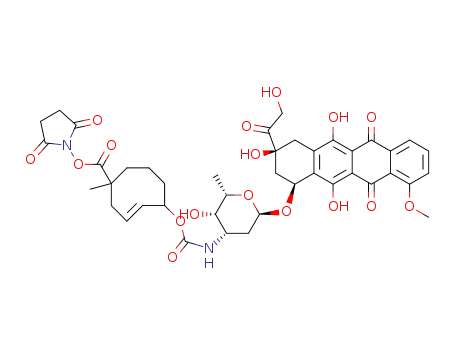
doxorubicin

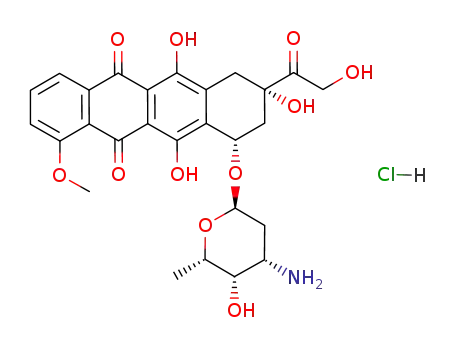
doxorubicin hydrochloride
| Conditions | Yield |
|---|---|
|
With
3,6-dimethyl-1,2,4,5-tetrazine;
In
acetonitrile;
Reagent/catalyst;
|
|
|
With
3,6-dimethyl-1,2,4,5-tetrazine;
In
acetonitrile;
Reagent/catalyst;
|
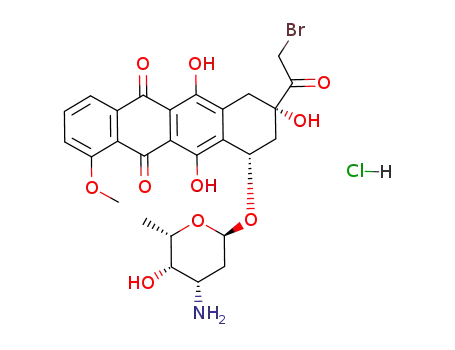
14-bromodaunorubicin hydrochloride


doxorubicin hydrochloride
| Conditions | Yield |
|---|---|
|
In
water; dimethyl sulfoxide;
at 80 ℃;
for 2h;
|
64% |

14-bromodaunorubicin hydrochloride
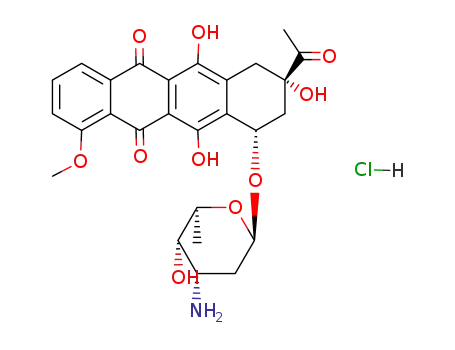
daunomycin hydrochloride
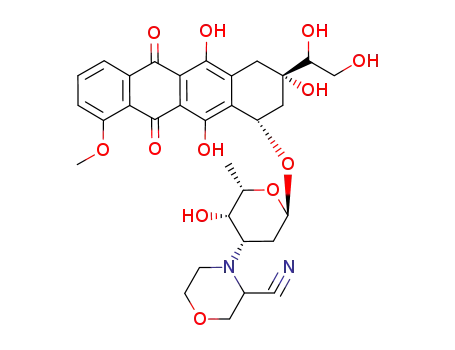
3'-deamino-3'-(3-cyano-4-morpholinyl)-13-dihydrodoxorubicin

3'-deamino-3'-(4-morpholinyl)-13-dihydrodoxorubicin
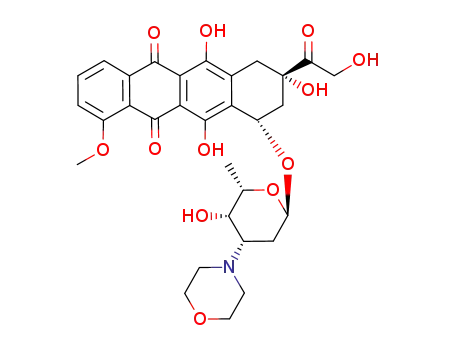
3'-deamino-3'-(4-morpholinyl)doxorubicin
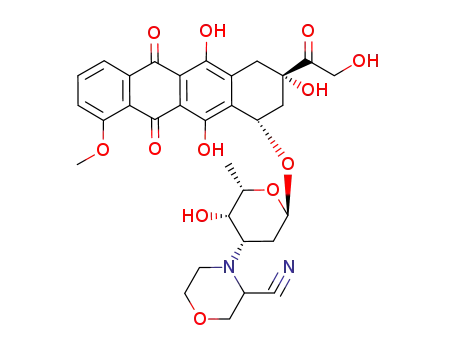
3'-deamino-3'-(3-cyano-4-morpholinyl)doxorubicin